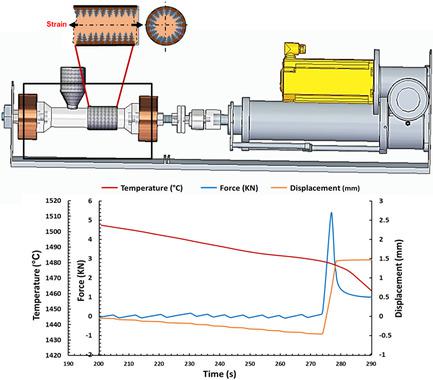当前位置:
X-MOL 学术
›
Steel Res. Int.
›
论文详情
Our official English website, www.x-mol.net, welcomes your
feedback! (Note: you will need to create a separate account there.)
Method to Investigate Mechanical Behavior of Steel Casting near Solidus Temperature
Steel Research International ( IF 1.9 ) Pub Date : 2021-04-29 , DOI: 10.1002/srin.202100007 Yanru Lu 1 , Laura N. Bartlett 1 , Ronald J. O'Malley 1 , Simon N. Lekakh 1
Steel Research International ( IF 1.9 ) Pub Date : 2021-04-29 , DOI: 10.1002/srin.202100007 Yanru Lu 1 , Laura N. Bartlett 1 , Ronald J. O'Malley 1 , Simon N. Lekakh 1
Affiliation

|
Hot crack formation in continuously cast steel is significantly influenced by the mechanical properties of the solid shell near its solidus temperature. Herein, a new method to study the high-temperature mechanical behavior of the solidifying steel shell is introduced. In this method, an apparatus is designed utilizing an electric cylinder that is controlled by a servomotor to apply a specified amount of strain to the solidifying steel shell at a controlled strain rate. A special mold configuration is developed to control the dendrite growth in the direction perpendicular to the applied strain and to ensure that the strain is applied in the region of controlled shell growth. Real-time load, displacement, and temperature data are monitored by a computer-assisted data acquisition system. The temperature profile of the casting is predicted by MAGMASOFT and compared with experimental data. The Fourier thermal analysis method is applied to calculate a solid fraction and coupled with the temperature profile to determine the solid shell thickness during the test. The maximum strength at different temperatures for a medium-carbon steel is determined and compared with that from the submerged split-chill tensile test and hot tensile tests.
中文翻译:

研究铸钢件在固相线温度附近的力学行为的方法
连铸钢中热裂纹的形成受固体壳在其固相线温度附近的机械性能的显着影响。在此,介绍了一种研究凝固钢壳高温力学行为的新方法。在该方法中,设计了一种设备,利用由伺服电机控制的电动缸以受控的应变速率将指定量的应变施加到凝固的钢壳上。开发了一种特殊的模具配置来控制垂直于施加应变的方向上的枝晶生长,并确保应变施加在受控的壳生长区域中。实时载荷、位移和温度数据由计算机辅助数据采集系统监控。铸件的温度分布由 MAGMASOFT 预测并与实验数据进行比较。应用傅里叶热分析方法计算固体分数,并结合温度曲线来确定测试过程中的固体壳厚度。确定了中碳钢在不同温度下的最大强度,并与浸入式劈裂拉伸试验和热拉伸试验的强度进行了比较。
更新日期:2021-04-29
中文翻译:

研究铸钢件在固相线温度附近的力学行为的方法
连铸钢中热裂纹的形成受固体壳在其固相线温度附近的机械性能的显着影响。在此,介绍了一种研究凝固钢壳高温力学行为的新方法。在该方法中,设计了一种设备,利用由伺服电机控制的电动缸以受控的应变速率将指定量的应变施加到凝固的钢壳上。开发了一种特殊的模具配置来控制垂直于施加应变的方向上的枝晶生长,并确保应变施加在受控的壳生长区域中。实时载荷、位移和温度数据由计算机辅助数据采集系统监控。铸件的温度分布由 MAGMASOFT 预测并与实验数据进行比较。应用傅里叶热分析方法计算固体分数,并结合温度曲线来确定测试过程中的固体壳厚度。确定了中碳钢在不同温度下的最大强度,并与浸入式劈裂拉伸试验和热拉伸试验的强度进行了比较。











































 京公网安备 11010802027423号
京公网安备 11010802027423号